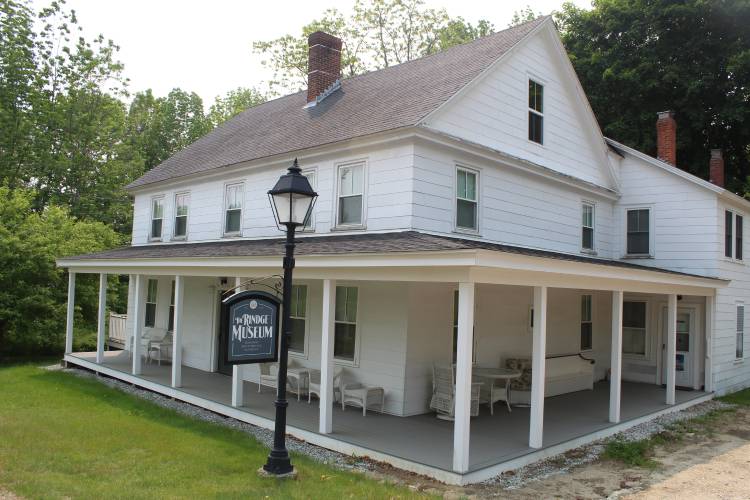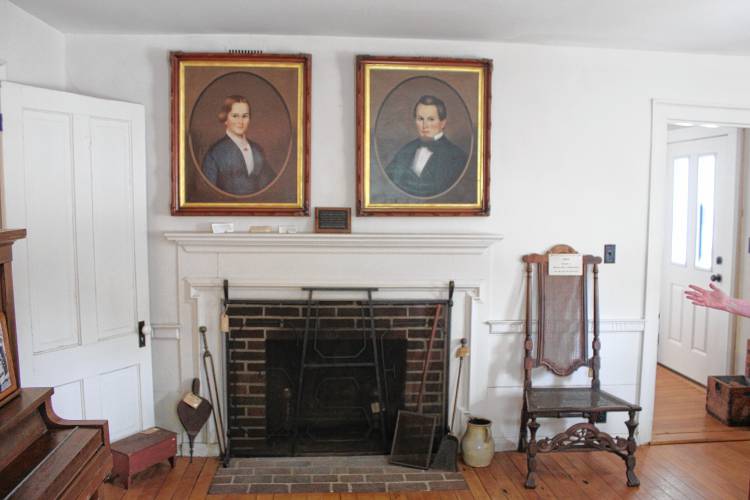The Freeborn Stearns house in Rindge finds new life as historical museum
| Published: 06-19-2023 12:58 PM |
The Freeborn Stearns House in Rindge center is filled with the historical artifacts of the town’s history, having been the home of the Rindge Historical Society Museum since 1995. But the house itself has its own rich history – well documented by its current caretakers, along with the rest of the town history.
The house was built circa 1815 for Freeborn Stearns, a farmer, blacksmith and militia captain who relocated to Rindge from Winchendon, Massachusetts. While the home has undergone some renovations since then, including an addition and the replacement of the previous barn with a new one, the interior has retained historical elements including wallpaper and floor panels laid out in different patterns from room to room.
Karla MacLeod, president of the Rindge Historical Society, said it was in the Stearns family until 1910 – almost 100 years.
Following Freeborn Stearns, the next generation, Julius Augustus Stearns and Mary Ann Stearns occupied the house. Julius was also a blacksmith, but following his death, Mary Ann added an ell to the house and took in boarders to support herself.
In 1910 the home was sold to Henry Hoyt, and was occupied by his parents Charles and Alice Hoyt. MacLeod has a special connection to the Hoyts, being a great-granddaughter of the family.
The Hoyts ran the property as Rindgehurst Farm, making use of the sprawling 40 acres of land that came with it. The house was brought into modernity with the addition of central heating and indoor plumbing. It was also around this time that the new cow barn was built, as well as a chicken house, both of which have since been removed.
With the working farm came multiple changes, though few of them remain – an orchard of 200 apple trees was planted in 1912, but was destroyed by the Hurricane of 1938.
MacLeod said the destruction of the old barn was apparently done with dynamite – an itemized list of construction done at the time includes a cost of $19.80 for the dynamite, and $20 for the labor of detonating it.
Article continues after...
Yesterday's Most Read Articles
 Katalina Davis dazzles in Mascenic shutout win
Katalina Davis dazzles in Mascenic shutout win
 Restorative justice author Leaf Seligman to speak at the Mariposa Museum
Restorative justice author Leaf Seligman to speak at the Mariposa Museum
 ‘Dork Dancing’ coming to Depot Square in Peterborough
‘Dork Dancing’ coming to Depot Square in Peterborough
 New photography studio opens on Jaffrey Main Street
New photography studio opens on Jaffrey Main Street
 UPDATE: Drivers identified in Jaffrey dump truck crash
UPDATE: Drivers identified in Jaffrey dump truck crash
It was also under the Hoyts ownership that the house was divided into two apartments, one for Charles and Alice, and the other occupied by their son Ralph.
Some of the work was done with a $5,000 loan from Harris Rice, who MacLeod said was a somewhat famous figure of the town at the time.
“He owned about a third of the town,” MacLeod said.
When Charles died in 1926, his son Ralph ran the farm until the death of his mother in 1941, at which time the loan defaulted and ownership went to Rice, who sold it to the Sloane family.
The Sloane family donated a portion of the 40 acres to be used for the Rindge Memorial School.
The last family to use the house was the Allen family, with Frank “Pop” Allen and Hazel Allen as residents. Following Hazel’s death in 1995, the property was purchased from her estate.
The Historical Society has taken down one of the barns and rebuilt a front porch, which was visible in earlier photos and paintings, but had been taken off at some point.
The home is now a museum. Both the house and the remaining barn house collections of agricultural and industrial artifacts, works of art, maps, books, photographs, diaries and letters dating back to the 18th century. Featured artifacts include the discharge papers of Eleazer Blake signed by George Washington, and the hand-painted sleigh of William Dean, a doctor murdered in Jaffrey in a case that remains unsolved to this day.
The museum is open on Wednesdays from 10 a.m. until noon, and on the first Saturday of each month from 10 a.m. until 2 p.m., or by appointment. For more information, visit rindgehistoricalsociety.org.
Ashley Saari can be reached at 603-924-7172 ext. 244 or asaari@ledgertranscript.com. She’s on Twitter @AshleySaariMLT.










